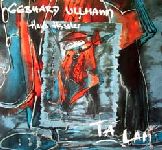Home » Jazz Articles » Album Review » Gebhard Ullmann: Ta Lam
Gebhard Ullmann: Ta Lam
Music such as this, whether it is considered jazz or not, just does not happen that often. To listen to it is to be drawn into another world and to be deeply touched. If the purpose of art is to communicate the essence of that which is human spirit, then Tá Lam should be considered with those works, in any medium, which show us who we are and what we can be.
Playing nine different instruments, Ullmann, by being exceedingly precise in his overdubbing and use of reverb and delay, has created a flute and reed orchestra with all the parts being meaningful and necessary. With respect to post-production, Dave Liebman states in the notes, "The mix of this recording is excellent with backgrounds truly placed behind and around solo voices."
Although this is primarily a solo performance, accordionist Hans Hassler, while not on every track, is of central importance. Hassler's very free style allows him to perfectly mix with and comment upon the music in which he finds himself.
The opening track, "Red Prixx (Allegretto)," which could just as well be a piece for a chamber reed orchestra, demonstrates all of this quite clearly. Hassler freely plays dissonant chords and lines, accompanied by a group of reeds. Flutes then enter playing the theme and the harmony shifts. Hassler is commenting the whole time, and ends with a dense cluster that makes sense harmonically.
At over eight minutes, the title track is the longest one and is a microcosm of everything that happens on the record. Ullmann's compositions lie on the edge of being classically constructed, with close attention paid to logical development and form, and yet he does swing. Rapid, rhythmically complex lines are expertly played by multiple instruments; Hassler weaves in, out and around the proceedings until they lead to an enchanting flute solo, which is answered by the recognizable theme and accordion. The last half of the piece is taken over by a free, but quite blue, bass clarinet solo with sparse accompaniment, finally ending beautifully alone.
Tá Lam is shocking in that Ullmann's earlier work does not, for the most part, prepare one for this musical world. It is as if he stepped back and reassessed where he was and where he wanted to go, with the result being this magnificent work, which contains many pieces that will be reworked a number of times for different groups on later records.
No matter how many times Tá Lam is listened to, its enormous range and depth will reveal something new, making it a record to be savored for years to come.
Track Listing
Red Prixx (Allegretto); Heaven No. 2.4; Ta Lam; Palimo Cabero; Oegarden's What?; Hommage To Purple Paintings; Mala Dr ole; Heaven No. 1; Polyphonic Mornings; D. Nee No; Seven Rests For Woodwind Ensemble; Blue Prixx (Allegro); Dre Open Two.
Personnel
Gebhard Ullmann
saxophoneGebhard Ullmann: piccolo flute, concert flute, alto flute, bass flute, wood flutes, soprano saxophone, alto saxophone, tenor saxophone, bass clarinets; Hans Hassler: accordion; E.C. Zander: piano (13).
Album information
Title: Ta Lam | Year Released: 2007 | Record Label: 99 Records
< Previous
Strokes
Next >
Hunter-Gatherers
Comments
About Gebhard Ullmann
Instrument: Saxophone
Related Articles | Concerts | Albums | Photos | Similar ToTags
Concerts
For the Love of Jazz
 All About Jazz has been a pillar of jazz since 1995, championing it as an art form and, more importantly, supporting the musicians who create it. Our enduring commitment has made "AAJ" one of the most culturally important websites of its kind, read by hundreds of thousands of fans, musicians and industry figures every month.
All About Jazz has been a pillar of jazz since 1995, championing it as an art form and, more importantly, supporting the musicians who create it. Our enduring commitment has made "AAJ" one of the most culturally important websites of its kind, read by hundreds of thousands of fans, musicians and industry figures every month.




















